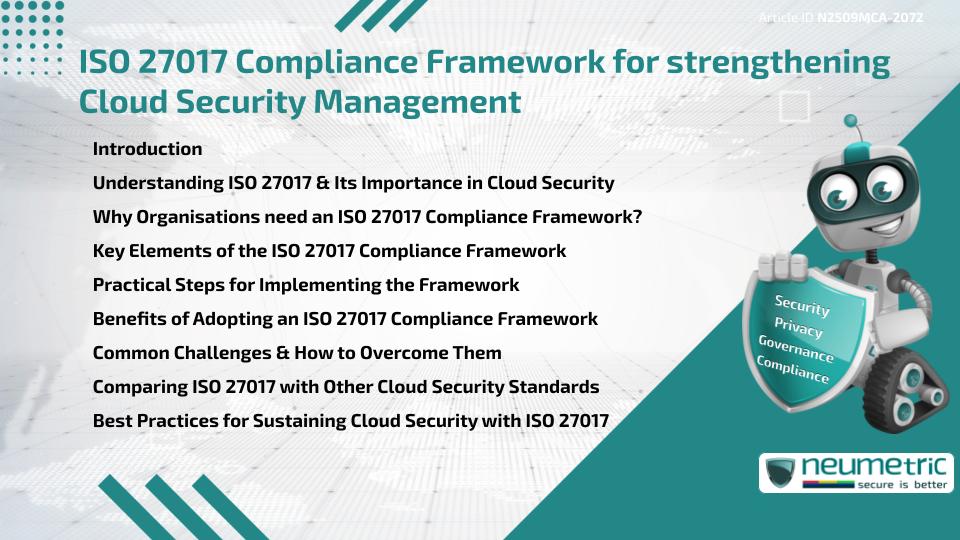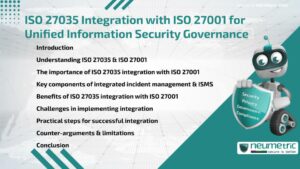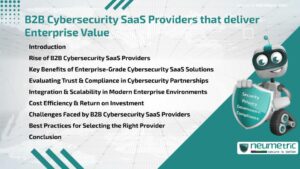Table of Contents
ToggleIntroduction
The ISO 27017 Compliance Framework is designed to help Organisations strengthen their Cloud Security Management practices. As Businesses increasingly rely on Cloud services, Risks related to Data Breaches, Misconfigurations & Unauthorised Access have grown. ISO 27017 provides a structured approach to address these Risks, ensuring shared Accountability between Cloud Service Providers & Customers. This article explores the importance of the ISO 27017 Compliance Framework, its elements, benefits, challenges & best practices for adoption.
Understanding ISO 27017 & Its Importance in Cloud Security
ISO 27017 is an international Standard that builds upon ISO 27002, offering specific guidance for Cloud Security Controls. It defines responsibilities for both Cloud Service Providers & Customers, covering areas like access Management, Data Handling, Monitoring & Incident Response.
With Cloud environments being dynamic & complex, having a tailored Framework helps Organisations safeguard Sensitive Information, meet Regulatory expectations & maintain Customer Trust.
Why Organisations need an ISO 27017 Compliance Framework?
Cloud environments differ significantly from On-premise Systems. Security is shared between Providers & Customers, but Responsibilities are often unclear. An ISO 27017 Compliance Framework provides clarity by outlining what each party must do to secure Data & Services.
Without such a Framework, Organisations Risk Security Gaps, Non-Compliance with Data Protection Laws & Reputational damage in case of Breaches.
Key Elements of the ISO 27017 Compliance Framework
An effective ISO 27017 Compliance Framework includes:
- Shared responsibility model: Defining roles between Providers & Customers.
- Data classification & protection: Applying Encryption, Segregation & secure Deletion.
- Identity & access Management: Implementing strong Authentication & Role-based Controls.
- Cloud Service Monitoring: Tracking System usage, Anomalies & Potential Threats.
- Incident Response Procedures: Ensuring clear processes for Breach Detection & Reporting.
- Vendor & Contract Management: Integrating Cloud-specific Security clauses in Agreements.
These elements provide a comprehensive structure for managing Cloud Security.
Practical Steps for Implementing the Framework
- Assess Cloud Risks: Identify Assets, Threats & Vulnerabilities in your environment.
- Map Responsibilities: Clarify what is managed internally versus by the Provider.
- Develop Policies: Establish Cloud-specific Security & Privacy Policies.
- Integrate Controls: Apply ISO 27017 Controls into Operational processes.
- Conduct Training: Educate Staff & Stakeholders on Cloud Security responsibilities.
- Perform Audits: Regularly test Compliance through Internal & Third Party Assessments.
This step-by-step approach ensures adoption is systematic & effective.
Benefits of Adopting an ISO 27017 Compliance Framework
- Greater clarity on shared Cloud Security Responsibilities.
- Enhanced Trust with Customers & Stakeholders.
- Improved Regulatory alignment with Global Data Protection Laws.
- Reduced Risk of Data Breaches & Misconfigurations.
- Strengthened Partnerships with Cloud Providers.
By adopting the ISO 27017 Compliance Framework, Organisations can move from reactive Security to proactive Management.
Common Challenges & How to Overcome Them
- Ambiguity in shared responsibilities: Mitigate by documenting clear agreements with Providers.
- Complex Cloud Environments: Address through Automation & centralised Monitoring Tools.
- High implementation Costs: prioritise Controls based on Risk Assessments.
- Employee Awareness gaps: Provide regular Training & Awareness programs.
Overcoming these challenges ensures the Framework is practical & sustainable.
Comparing ISO 27017 with Other Cloud Security Standards
ISO 27017 differs from frameworks like SOC 2 or CSA STAR by providing detailed, prescriptive guidance for Cloud-specific Controls. While SOC 2 focuses on Trust Principles & CSA STAR emphasises Certification for Providers, the ISO 27017 Compliance Framework directly bridges the gap between Providers & Customers.
Best Practices for Sustaining Cloud Security with ISO 27017
- Continuously review & update Cloud Policies.
- Monitor Cloud activities with automated tools.
- Include Cloud-specific clauses in all Vendor Contracts.
- Conduct regular Third Party Audits.
- Engage Leadership in Cloud Security decision-making.
Sustaining Cloud Security requires treating the Framework as a living system rather than a one-time project.
Conclusion
The ISO 27017 Compliance Framework provides Organisations with a practical, globally recognised structure for managing Cloud Security. By defining Responsibilities, strengthening Controls & supporting Regulatory Compliance, it helps enterprises safeguard Sensitive Data & maintain Trust in Cloud Environments.
Takeaways
- The ISO 27017 Compliance Framework addresses Cloud-specific Security needs.
- It clarifies shared responsibilities between Providers & Customers.
- Key elements include Access Control, Monitoring & Incident Response.
- Challenges like Cost & Complexity can be managed with planning.
- Sustained Compliance requires regular Reviews, Audits & Awareness Programs.
FAQ
What is the ISO 27017 Compliance Framework?
It is a structured approach based on ISO 27017, offering Cloud-specific Security Controls for Providers & Customers.
Why is ISO 27017 important for Cloud Security?
It addresses Risks unique to Cloud Environments & clarifies shared responsibilities.
Does ISO 27017 replace ISO 27001?
No, it complements ISO 27001 by adding guidance for Cloud Security Management.
Who benefits from the ISO 27017 Compliance Framework?
Both Cloud Service Providers & Customers benefit through improved Clarity & Trust.
How does ISO 27017 compare to SOC 2?
SOC 2 evaluates Trust Principles, while ISO 27017 provides detailed Cloud-specific Controls.
Is ISO 27017 mandatory for Cloud Providers?
It is not mandatory but widely recognised as best practice for Cloud Security.
How often should Compliance be reviewed?
Regular Audits & Reviews should occur annually or whenever significant Cloud changes take place.
Need help for Security, Privacy, Governance & VAPT?
Neumetric provides organisations the necessary help to achieve their Cybersecurity, Compliance, Governance, Privacy, Certifications & Pentesting needs.
Organisations & Businesses, specifically those which provide SaaS & AI Solutions in the Fintech, BFSI & other regulated sectors, usually need a Cybersecurity Partner for meeting & maintaining the ongoing Security & Privacy needs & requirements of their Enterprise Clients & Privacy conscious Customers.
SOC 2, ISO 27001, ISO 42001, NIST, HIPAA, HECVAT, EU GDPR are some of the Frameworks that are served by Fusion – a SaaS, multimodular, multitenant, centralised, automated, Cybersecurity & Compliance Management system.
Neumetric also provides Expert Services for technical security which covers VAPT for Web Applications, APIs, iOS & Android Mobile Apps, Security Testing for AWS & other Cloud Environments & Cloud Infrastructure & other similar scopes.
Reach out to us by Email or filling out the Contact Form…





